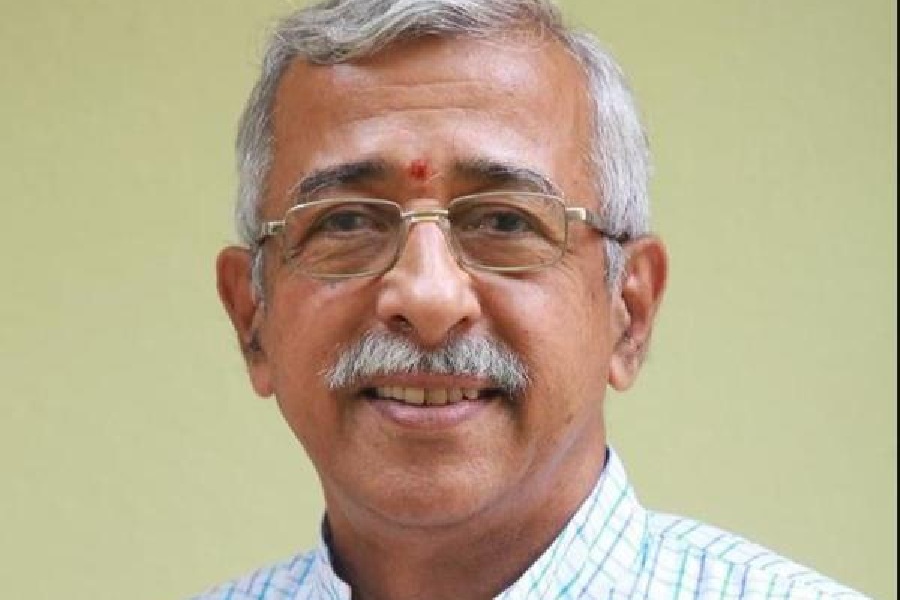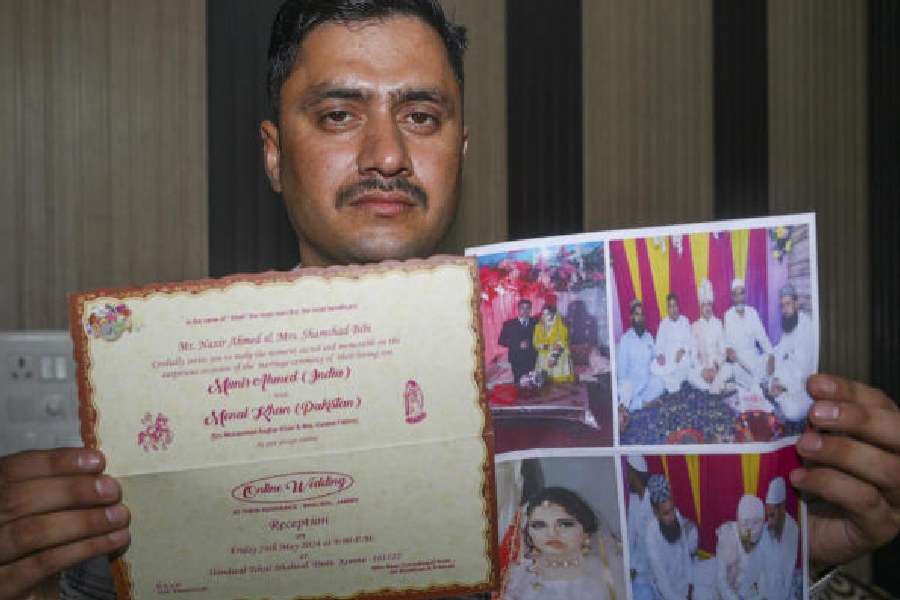 |
Bangalore, Nov. 8: On a remote beach in southern Karnataka, Swami Bhakti Gaurava Narasingha does what no ochre-robed sadhu has probably done before as part of his daily prayer rhythm. He surfs.
Clad in a T-shirt and shorts, the 64-year-old US-born swami rides the waves on a surfboard inscribed with an “Om” in the Devanagari script. With him is his band of young “Surfin’ Swamis”, as they call themselves, who are quietly popularising a water sport that has a global fan following but is practically non-existent in India despite its 7,500km coastline.
But here’s the difference: Swami Narasingha runs a surfing ashram where the water sport is an extension of the prayers, bhajans and puja — a form of meditation for the surfers who see a spiritual connection in spotting and catching waves.
“It’s quite connected in that way,” said the swami, born Jack Hebner in Florida, whose outlook draws on the identification of God with Nature in Indian scriptures.
“If you ask a surfer, say from America or Australia, if he thought it was a spiritual experience, he may explain it but he won’t relate it to the Gita... he won’t relate it to the Vishwaroopa. That’s something only someone with an Indian cultural background and spiritual education (can do).”
Hebner, who began surfing in Florida and Hawaii in 1963 as a teenager, became a Hindu monk in the late ’60s after meeting A.C. Bhaktivedanta Swami Prabhupada, founder of the International Society for Krishna Consciousness (Iskcon), but moved away from the organisation after his guru’s death in 1977.
In 1994, he set up an ashram near Mysore, which now has about 150 members, most of them from Karnataka.
The idea of the Mantra Surf Club at Mulki, some 30km north of Mangalore where the river Shambhavi meets the Arabian Sea, came about four years ago when he was teaching a few of his boys to bodysurf near Mahabalipuram in Tamil Nadu.
“They all got excited about it and I called a friend of mine and said the next time you come to India, bring me a couple of surfboards,” the Swami said.
The “Surfin’ Swamis” normally begin their day at 4am with morning prayers and go out to surf a couple of hours later, their strange sport inspiring many young boys, mostly from fishermen’s families in Mulki.
The Swami reckons the sport really has not caught on in India because there hasn’t been an icon.
“(Maybe) If Sachin (Tendulkar) is seen with a surfboard under his arm… people in India are very influenced by cricket and by Bollywood,” he said.
“That’s what happened in America. It was just plodding along --- a few surfers in Hawaii, California ---- they were called beach bums. Then there came a movie from Hollywood called Gidget in the late ’50s and the world culture of a few hundred people doing surfing exploded into two million,” the Swami said.
But at least one person associated with the cricketing icon has been surfing at the surfing ashram, which can accommodate eight guests at a time. Paddy Upton, the Indian cricket team’s mental conditioning coach, visited the Mantra Surf Club a year ago.
“The big thing that really needs surfing to happen is a beach culture,” said Upton, who has been surfing for about 25 years.
He thinks the sport is bound to grow, especially with India being described by international sports magazines as one of the new frontiers for the surfing world to discover. “I would say it would need to be combined with surfing and the Indian experience, as opposed to just coming to surf,” he said.
“Upton (has) been to our ashram and as soon as this month is over, the cricket team will be in Bangalore and all the ashram cricket boys and surfer boys will be going to a match,” the Swami said.
“The last time we went to a match we had breakfast at one of the big five-star hotels with the whole cricket team and the whole team signed our surf book, so we know a lot of people in the sports world and with their endorsement, one of these big corporates is going to sponsor us.”
The Swami is talking to corporate houses for sponsoring a surf team of boys in their 20s from Pondicherry while he is also putting together a sports adventure film on surfing in India. “Our Indian boys will be in that film along with the top world-class surfers,” he said.
The proceeds from the surfing ashram — which is strictly vegetarian, doesn’t allow smoking and drinking and also requests guests to maintain celibacy while they are there — help support its activities.
“We don’t ask for donations. We like to support ourselves,” said Kunjabihari, a 23-year-old from Mandya who joined the ashram after leaving school in Class IX. Now, he runs a business of importing surfboards and selling them in India.
Like most young boys at the ashram, Kunjabihari learnt to use computers, photography and to design websites from the Swami and other older members.
“We have from the IT industry in Bangalore about half-a-dozen engineers who come at the weekend and share their learning with the boys,” said Swami Narasingha. The ashram also supports itself through designing websites and by selling photographs through a website.
“I haven’t yet seen someone who hasn’t shown interest (in the surf club),” said Archana Krishnamurthy, chief consultant (Asia) of Streisand Inc, a consultancy whose parent group, Streisands, has been closely involved with the ashram and also runs an art gallery in Bangalore to support it.
Archana also helps it to connect to the corporate world. At least six of the eight guests the surfing ashram can accommodate at a time are usually foreigners. “They really like the ashram experience,” Archana said.
“There are about 3 million sadhus in India, who wear saffron and rudraksha and do mantram,” said Swami Narasingha. “I’m the only one that surfs.”










